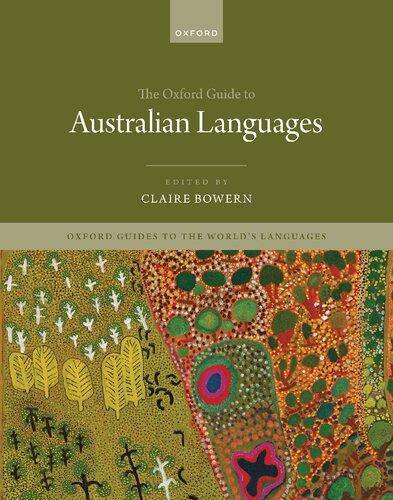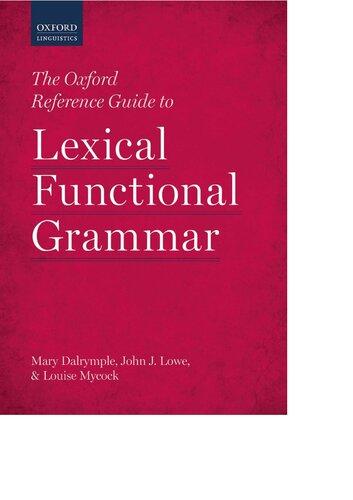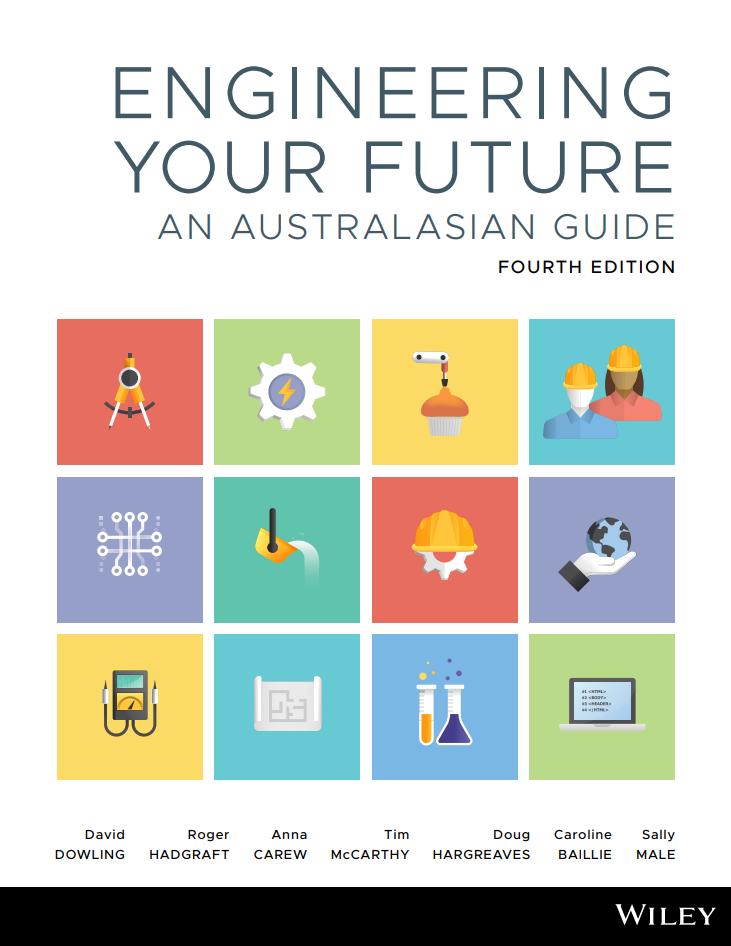Shortcontents
Detailedcontents
Seriespreface
Abbreviationsandconventions
Thecontributors
Languagemaps
Australianlanguagefamiliesandlinguisticclassifications lxvii Foreword xcv KadoMuir
1.Introduction 1 ClaireBowern
Background
2.AhistoryoftheearlydescriptionofAustralianlanguages
ClaraStockigt
3.DocumentationofAustralianlanguages
NicholasThieberger
4.Australianlanguagesandsyntactictheory
RachelNordlinger
5.Australianlanguagesandinterdisciplinaryapproachestothepast
LuisaMiceliandClaireBowern
6.Nineteenth-centuryclassificationsofAustralianlanguages 46 ClaraStockigt
7.HowmanylanguagesareandwerespokeninAustralia?
ClaireBowern
8.PhilologicalmethodsforAustralianlanguages
JohnGiaconandHaroldKoch
9.Articulatoryandacousticphonetics
MarijaTabain 10.Segmentinventories
ErichR.Round
31.Reflexivesandreciprocals 360 AliceGaby
32.Tenseandaspect 378 JamesBednall
33.Modalityandmood 392 JamesBednall
34.Negation 411 JoshPhillips
35.Wordorder 424 MagdaAndrews-HokeandParkerBrody
36.Questions 434 JuhyaeKimandClaireBowern
37.Subordination 446 Marie-ElainevanEgmond
38.Relativeclauses 457 RachelHendery
39.Antipassives 468 JessicaDenniss
40.Morphologicalchange 482 BarryAlpherandClaireBowern
C.Semantics,pragmatics,anddiscourse
41.Quantification 499 MargitBowlerandIvanKapitonov
42.Directionandlocation 513 DorotheaHoffmann
43.Kinship,marriage,andskins 520 PatrickMcConvell
44.Toponyms 530 KatherineRosenberg,JaneSimpson,andClaireBowern
45.Discourseandsocialinteraction 538 JoeBlytheandIlanaMushin
46.Narrative 548 FrancescaMerlan
47.Interjections 564 MaïaPonsonnet
48.Insultsandcompliments 573 MichaelWalsh
49.Languagenames
KatherineRosenbergandClaireBowern
50.TheverbalartsinIndigenousAustralia
JenniferGreen,IngeKral,andSallyTreloyn
51.Sociolinguisticvariation
JohnMansfield
52.AustralianIndigenoussignlanguages
JenniferGreen
53.Gender-baseddialects
JohnBradleyandAliceGaby
54.Multilingualism
JillVaughan
55.Code-switching
58.Youngpeople’svarieties
CarmelO’Shannessy
59.Restrictedrespectregistersandauxiliarylanguages
MichaelWalsh
60.Languageinputandchild-directedspeech
LucindaDavidson,BarbaraKelly,GillianWigglesworth,and RachelNordlinger
CatherineBow 64.Languagerevival
MaryanneGale
65.Language,land,identity,andwellbeing 754 RobAmeryandMaryanneGale
PARTV: Structuralsketchesoflanguages,subgroups,andfamilies 763
66.Contactlanguagecasestudies 765 DeniseAngelo
67.TheGunwinyguanlanguages 781 NicholasEvansandAlexandraMarley
68.Anindilyakwa 796 Marie-ElainevanEgmond
69.LanguagesoftheKimberleyregion 812 StefSpronck
70.TheManingridalanguages 825 MargaretCarewandDavidFelipeGuerreroBeltran
71.LivinglanguagesofVictoria 845 K.Eira
72.Lamalamic(Paman) 855 Jean-ChristopheVerstraete
73.TheBandjalangiclanguagesanddialects 865 MargaretSharpe
74.Noongar 876
DeniseSmith-Ali,SueHanson,GeorgeHayden,ClaireBowern, AkshayAitha,LydiaDing,andSarahMihuc
75.TheWati(WesternDesert)subgroupofPama-Nyungan 893 SarahBabinski,Luis-MiguelRojas-Berscia,andClaireBowern
76.Ngumpin-Yapalanguages 918 FelicityMeakins,ThomasEnnever,DavidOsgarby,Mitch Browne,andAmandaHamilton-Hollaway
77.Wajarri 933 DougMarmion
78.TherevitalizationofthesleepingTasmanianAboriginallanguages palawakani 950 AnnieReynoldsandTheresaSainty
References 958
LanguageandLanguageFamilyindex 1061
Indexofplacesmentioned 1072
Subjectindex 1074
3. DocumentationofAustralianlanguages 23
NicholasThieberger
3.1Introduction
3.2Whydocumentation?
3.3WhatrecordsofAustralianlanguagesarethereandhowmuchisthere foreachlanguage?
3.4WheretolookforrecordsofAustralianlanguages 26
3.5AccessingandpresentingearlysourcesonAustralianlanguages
3.6Lossofdocumentation 30
3.7Conclusions
4. Australianlanguagesandsyntactictheory 31
RachelNordlinger
4.1Introduction
4.2Phrasestructureandnonconfigurationality
4.3Ergativity
4.4Casestacking
5. Australianlanguagesandinterdisciplinaryapproachestothepast 37
LuisaMiceliandClaireBowern
5.1Introduction 37
5.1.1 Overview
5.1.2 Anaside:theAustralianpastas‘deephistory’
5.2Problemswithinlinguistics
5.2.1 Missinginformation
5.2.2 Soundchange
5.2.3 Languagecontact
5.2.4 Stasis
5.3Linguisticsandgeneticsandwheretheydisagree:acasestudyofthree trees 41
5.3.1 Domainspecificityandassumptionsaboutchange 41
5.3.2 Arethelanguagedatestooyoung? 42
5.3.3 Arethegeneticdatestooold? 44
5.4Conclusions 45
6. Nineteenth-centuryclassificationsofAustralianlanguages 46
ClaraStockigt
6.1Introduction 46
6.2TherelatednessofAustralianlanguages
6.3Earlygrammaticaltypologiessupportingthenotionofrelatedness 47
6.3.1 DisseminationofinformationaboutAustralianlanguages 50
6.3.2 Developmentofterminologyreferringtolinguisticentities 51
6.3.3 Northernandsouthernmainlandlanguages 52
6.3.4 Subgroupsof‘southern’languages 54
6.3.5 EarlyrankingsofAustraliansubgroups 55
6.4Concludingcomment 55
10. Segmentinventories
ErichR.Round
10.1Mainparametersofvariationinconsonantinventories
10.2Additionalconsonantalsegmenttypes
10.2.1 Fricatives
10.2.2 Glides,laterals,andvibrants
10.2.3 Additionalplacesofarticulation
10.2.4 Labializedconsonants
10.3Uncommonabsencesfromconsonantinventories
10.4Diversityintwo-seriesstopsystems
10.5Vowels
10.6Prospective
10.7Sources
11. Phonotactics 106
ErichR.Round
11.1Consonantphonotactics:mainparametersofvariation
11.1.1 Dixon’sandHamilton’sgeneralizations
11.1.2 Laryngealconsonants
11.1.3 Superlaryngealclustersacrossthecontinent
11.2Statisticalharmonyofvowelsinadjacentsyllables 111
11.2.1 Statisticalfront–backharmonyinnon-lowvowels 111
11.2.2 The*iCuconstraintonnon-lowvowels 111
11.2.3 Statisticalmid-vowelmetaphony 112
11.3Australiancontoursegments:attheedgeofsegmentandsequence 112
11.3.1 Initialnasal+stop 113
11.3.2 Stop+lateral 114
11.3.3 Stop+nasal 115
11.4Prospective 117 11.5Sources
12. Morphophonology:Lenitionandassimilation 120
ErichR.Round
12.1Materialsandmethods 120 12.2Lenition 121
12.2.1 Participationofstopsinlenitionalternations,byplaceofarticulation. 121
12.2.2 Pairingsbetweenstopsandlenisalternants 122
12.2.3 One-to-manyandmany-to-onepairings 123
12.2.4 Rangesofplacesofarticulationforlenition 124
12.2.5 Phonologicaltriggers 125
12.2.6 Morphologicalconditioning 126
12.2.7 Discussion:synchronicanalysisaslenitionorfortition 126
12.2.8 Summary 128
12.3Assimilation 128
12.3.1 Assimilationbetweenconsonants 128
12.3.1.1 Hypothesesbasedonstaticphonotactics 129
12.3.1.2 Placeassimilation 130
12.3.1.3 Mannerassimilation 132
12.3.1.4 Assimilationofbothplaceandmanner 132
12.3.2 Assimilationbetweenvowelsinadjacentsyllables
15. Intonation 159
JanetFletcher
15.1Introduction 159
15.2ProsodicstructureandintonationalcategoriesinAustralianlanguages 159
15.3Sentencemodalityandgrammaticalstructure 160
15.4Alignmentwithgrammaticalconstituents 162
15.5Discourseandinformationstructure 163
15.6Conclusions 164
16. Soundchange 165
BarryAlpher
16.1Introduction 165
16.2Changesinconsonantinventories:manners 166
16.2.1 Innovationofcontrastiveobstruentmanners 166
16.2.1.1 Contrastivestopseriespossiblyduetovowel-lengthmerger 166
16.2.1.2 Stopmannercontrastspossiblyoriginatingfromloanwords 167
16.2.1.3 Mannercontrastinnon-apicalstops 167
16.2.1.4 Mannercontrastinapicalstopsonly 167
16.2.1.5 Athree-wayobstruentmannercontrast 167
16.2.1.6 Contrastivefortisstopsconditionedbyadjacentsonorants 167
16.2.1.7 Contrastivevoicedstopsoriginatingfromprestoppednasals 168
16.2.2 Otherobstruentseries:spirantsandprenasalizedstops 168
16.2.2.1 Spirants 168
16.2.2.2 Spirantsoriginatingfromnasal-stopclusters 169
16.2.2.3 Prenasalizedstops 169
16.3Lenitionconflatingstopsandliquidswithcorrespondingglides 169
16.3.1 Lenitionofinitialstop 169
16.3.2 Lenitionofmedialstops 169
16.3.3 Lenitionofliquidstoglides 170
16.3.4 Chainshifts 170
16.4Changesinvowelinventories 170
16.4.1 Acoupleoffour-vowelsystems 170
16.4.2 Developmentofsomefive-vowelsystems 171
16.4.3 Separatedevelopmentofstructurallyidenticalsix-vowelsystems 172
16.4.4 Lossandreinstatementofvowel-lengthcontrasts 173
16.5Vowelassimilationacrossconsonants 173
16.5.1 Regressive 173
16.5.2 Progressive 173
16.5.3 Progressiveassimilationprecedinginitial-dropping 174
16.6Initial-dropping 174
16.6.1 SegmentallyconditionedC-loss 174
16.6.2 Stress-conditionedC-Loss(Blevins2001b:484–5) 175
16.7Alterationsofconsonantclusters 176
16.8Lossofunstressedvowels,includingrhythmicreduction 178
16.9Mergersandotherchangeswithlaminalsandapicals 179
16.10Consonantfortitionsnotcreatingnewmannerseries 180
16.10.1 FortitionofinitialC 180
16.10.2 FortitionofintervocalicC 181
16.10.3 FortitionofaCadjacenttoaC 181
16.10.4 Fortitionofaword-finalC 182
16.11Creationofindividualsoundsnotpreviouslyintheinventory 182
B.Morphosyntax
17. Wordclasses
OliverShoulson
17.1Introduction
18. Thenounphrase
DanaLouagie 18.1Introduction
19. Nounclasses 205
AmaliaSkilton
19.1Introduction 205
19.2Typesofnounclassificationsystem 205
19.2.1 Nounclasssystems 205
19.2.2 Classifiersandgeneric-specificconstructions 206
19.3Nounclasssystems 206
19.3.1 Geographicalandgeneticdistribution 207
19.3.2 Numberofnounclasses 207
19.3.3 Basisofnounclassassignment 207
19.3.3.1 Semanticbasis 207
19.3.3.1.1 Humannouns 207
19.3.3.1.2 Animalspecies 207
19.3.3.1.3 Inanimates 208
19.3.3.1.4 Identifyingadefaultnounclass 209
19.3.3.2 Phonologicalbasis 209
19.3.4 Covertvs.overtnounclass 210
19.3.5 Interactionsbetweennounclassandnumber 211
19.3.6 Targetsofnounclassagreement 212
19.4Strictsemanticnounclasssystems 213
19.4.1 Strictsemanticnounclasssystemsinnon-Pama-Nyunganlanguages 213
19.4.2 StrictsemanticnounclasssystemsinPama-Nyunganlanguages 213
19.5Classifiersandgeneric-specificconstructionscomparedtonounclass 214
19.5.1 TheclassifiersystemofMurrinhpatha 214 19.5.2 Otherintersectingsystemsofnominalclassification 215
19.6Furtherreading 215 19.7Conclusion 215
20. Ergativity 217 VivienDunnandFelicityMeakins
20.1Introduction 217
20.2Morphologicalergativity 217
20.3Syntacticergativity 218
20.4Splitergativity 221
20.5Optionalergativity 223 20.6Conclusion 225
21. Semanticcase 226 JaneSimpson
21.1Introduction 226
21.1.1 Typesofcase 226
21.1.2 Historyofterminology 229
21.2Forms 231
21.2.1 Allomorphy 231
21.2.1.1 Cardinaldirectionsandplacenames 231
21.2.1.2 Caseformativesbuiltonothercaseformatives 233
21.2.2 Derivation 233
21.3Syntacticproperties 234
21.3.1 Positionwithinthenominalphrase 234
21.3.2 Positionwithinadpositionalphrase 234
21.3.3 Case-stacking
21.4.1 Locationinspaceat,to,andfrom
Location
21.4.1.2 Motion/direction/orientationtowards
Motionfrom,source
21.4.3.1 Affixedtothepossessor
21.4.3.2 Affixedtothepossessionorproperty
22. Possession
MaïaPonsonnet
22.1Introduction
22.1.2 Definitionsandlabels
22.2Proprietiveandprivativesuffixes
22.3ThePama-Nyunganprofile
22.3.1 Dependent-markingconstructions
Thepart–wholeconstruction
22.4Non-Pama-Nyungantrends
22.4.1 Adnominalstrategies
22.4.1.1 Head-markingconstructions
22.4.1.4 Part–wholeconstructionsandtheirhistoricaltraces
22.4.3 Kinterms
22.4.4 Summaryoninalienabilityinnon-Pama-Nyunganlanguages
22.5InalienabilityandpossessionclassesinAustralianlanguages
22.5.1 Possessionclassesvs.nounclasses
22.5.2 Trans-continentalsemanticpatterns
23. Demonstratives
23.2.1 Freeandboundforms
23.2.2 Distributionandcategorialstatus
23.2.3 Inflectionalpossibilities
23.2.3.1 Case
23.2.3.2 Nounclass
23.2.3.3 Number
23.2.3.4 Person
23.2.4 Relationtothirdpersonpronouns
23.2.5 Useinnominalexpressions
23.2.5.1 Wordordertendencies
23.2.5.2 Determinerslots
23.3Semanticsanduse
23.3.1 Exophoricfunction:Spatial(andnon-spatial)deixis
23.3.2 Anaphoric,cataphoric,anddiscoursedeicticfunctions
23.3.3 Recognitionalfunction
23.4Signsofgrammaticalization
23.5Conclusion
Acknowledgements
24. Pronouns 268
AliceGabyandOliverShoulson
24.1Introduction
24.2Paradigmsofpersonalpronouns
24.2.1 Person
24.2.2 Number
24.2.3 Genderandclass
24.2.4 Case
24.2.5 Tense,aspect,andmood
24.2.6 Kinship
24.3Morphosyntaxofpersonalpronouns
24.3.1 Boundpronouns
24.3.1.1 Verbalprefixes
24.3.1.2 Encliticpronouns
24.3.1.3 Auxiliaries
24.3.2 Pronounsandthenounphrase
24.4Otherkindsofpronoun
24.4.1 Possessivepronouns
24.4.2 Intensifierpronouns
24.4.3 Reflexiveandreciprocalpronouns
24.4.4 Demonstrativepronouns
24.4.5 Interrogativeandindefinitepronouns
24.5Pronounsindiachroniccontext
25. Adjectivesandadverbs 278 JuhyaeKim
25.1Introduction
25.2Adjectives:Adistinctiveclass?
25.2.1 Adjectiveidentificationcriteria
25.2.1.1 Semanticcriteria
25.2.1.2 Distributionalcriteria
25.2.1.3 Syntacticcriteria
25.2.1.4 Morphologicalcriteria
25.2.1.5 Nodistinction
25.2.2 Summaryofadjectiveclassifications
25.2.3 Adjectivereduplication
25.2.3.1 Form
25.2.3.2 Semanticeffect
25.2.4 Adjectivederivationsandtheirrelationtootherwordclasses
25.3.2.1
25.3.2.3
28. Agreementmorphology 319 ParkerBrody
28.1Preliminaries 319
28.2Anatomyofagreement 319
28.3Agreementintheverbaldomain 321
28.4Agreementinthenominaldomain 323
28.5Conclusion 327
29. Suppletion 328 XavierBachandErichR.Round
29.1Introduction,definitions 328
29.2Materialsandmethods 329
29.3Verbalsuppletion 329
29.3.1 Tenseandaspect 329
29.3.2 Mood(includingimperatives) 331
29.3.3 Number 331
29.3.4 Othercategoricaltypes 332
29.3.5 Non-categoricalsuppletion 335
29.3.6 Lexicalmeanings 335
29.4Suppletionbeyondverbs 335
29.4.1 Pronouns,demonstratives,determiners,anddirectionals 336
29.4.2 Kinterms 337
29.4.3 Nominalandadjectivalincorporationandcompounding 338
29.4.4 Othernominalandadjectivalroots 341
29.5Conclusion 343
30. Valencychangeandcausation 344 StefSpronck
30.1Transitivity 344
30.1.1 Valencychange 345
30.1.2 Causation 346
30.1.2.1 Internalcausation 347
30.1.2.2 Externalcausation 347
30.1.2.3 Othertypesofcausation 348
30.1.3 Applicatives 348
30.2Sampling 348
30.3CausativesinAustralianlanguages 349
30.3.1 Causativeaffixes 349
30.3.2 Periphrasticconstructions 352
30.3.2.1 Lightverbsandauxiliaries 352
30.3.2.2 Serialverbconstructions 353
30.3.2.3 Indirectcausation 353
30.3.3 Distributionofcausatives 354
30.4Applicativesandothervalencyextensions 355
30.4.1 Applicativefunctions 355
30.4.2 Distributionofapplicatives 358
30.5Anticausatives 358
30.6Implications:Discussionandconclusion 359 Acknowledgements 359
31. Reflexivesandreciprocals
AliceGaby
JamesBednall
32.3.1 Inflectionaltense/aspectmarkinginnon-Pama-Nyunganlanguages
32.3.2 Inflectionaltense/aspectmarkinginPama-Nyunganlanguages
32.4Selectedtopicsinaspectuo-temporalexpression
32.4.1
32.4.1.4
32.4.1.4.2 Inflectionaltemporalmarkingonpronouns
32.4.2.1
33. Modalityandmood 392
JamesBednall
33.1Introduction 392
33.2Modalityandmood:Somepreliminaries 392
33.3ModalmarkinginAustralianlanguages:Abriefoverview 393
33.4InflectionalmodalmarkinginAustralianlanguages 395
33.4.1 Non-Pama-Nyunganlanguages 396
33.4.1.1 Formofinflectionalmodalmarkinginnon-Pama-Nyungan languages 396
33.4.1.2 Irrealisandrealis 398
33.4.1.3 Semanticsofinflectionalmodalmarkingin non-Pama-Nyunganlanguages 399
33.4.1.3.1 Openpossibilities 399
33.4.1.3.2 Foreclosed(counterfactual)possibilities 404
33.4.2 Pama-Nyunganlanguages 406
33.4.2.1 FormofinflectionalmodalmarkinginPama-Nyungan languages 406
33.4.2.2 SemanticsofinflectionalmodalmarkinginPama-Nyungan languages 406
33.4.2.2.1 Epistemicmodality 406
33.4.2.2.2 Deonticmodality 407
33.4.2.2.3 Dynamicmodality(incl.abilitymodals) 408
33.4.2.2.4 Teleological-intentionalandbouleticmodality 408
33.4.2.2.5 Apprehensivemodality 409
33.4.2.2.6 Foreclosedcounterfactuals 409
33.4.2.2.7 Negation 409
33.5Sententialmood 410
33.6Conclusion 410 Acknowledgements 410
34. Negation 411 JoshPhillips
34.1Introduction 411
34.2‘Standard’(clausal)negation 411
34.2.1 Theanalyticstandardnegator 411
34.2.2 Fusion:Thestatusofnegationintheverbalparadigm 413
34.2.2.1 Fusionoftenseandpolarity 413
34.2.2.2 Tensemarkingundernegation 413
34.2.2.3 Theirrealisnegator 414
34.2.2.4 Negation,‘realitystatus’andtheverbalparadigm 415
34.2.3 Negationand‘nonrealized’moods 417
34.3Negativeimperatives 417
34.4Nominalnegation 419
34.4.1 Negativeexistentials 420
34.4.2 Theprivative 421
34.5Suppletive/lexicalnegatives 422
34.6Conclusion 423
35. Wordorder
35.2.4
35.2.5
36.3Syntaxofquestions
36.4Semanticsandpragmaticsofquestions
36.4.1
36.4.2
36.4.3
37.2Hale’s(1976a)‘adjoinedrelativeclause’andNordlinger’s(2006b)reply
37.4Switch-referenceinnon-finiteclauses
37.6Complementizercase
37.7Subordinationandpolysynthesis
38.2Definingrelativeclauses 458
38.3Relativeclausesintypologicalperspective 459
38.4Adjoinedrelativeclauses 459
38.5Nominalizedandparticipialrelativeclauses 462
38.6Relativeclausepositionandwordorder 463
38.7Relativeclausemarkers 465
38.8RelativeclausesInKriol 466
38.9Conclusions 466
39. Antipassives 468
JessicaDenniss
39.1Introduction 468
39.2Morphosyntax 469
39.2.1 Casemarkingandagreement 469
39.2.2 Verbmarking 469
39.3Semanticfunctions 470
39.3.1 Aspectualreadings 471
39.3.2 Modalreadings 473
39.3.3 Lexicalshifts 474
39.3.4 Non-individuatedobjects 475
39.4Syntacticfunctions 477
39.5Grammaticalizationpatterns 478
39.6Othersemi-transitiveconstructions 478
39.7Conclusion 481 Acknowledgements 481
40. Morphologicalchange 482
BarryAlpherandClaireBowern
40.1Introduction 482
40.2Changesinvolvingclitics 482
40.2.1 Changeinmorphologicalmarkingandcategories 482
40.2.2 DistributionofdativecliticsinEasternDaly 483
40.3Changeinthesemanticorganizationofparadigms 484
40.3.1 Functionalchangewithnolinearchange 484
40.3.2 Adaptationofmorphemesfromotherparadigms 485
40.3.3 Introductionofaperson-numberformfromoneparadigmwhereit isregularintoanotherwhereitcreatesanirregularity 485
40.3.4 Reshapingofparadigms:Lossofagreement 486
40.4NominaltenseandaspectinPama-Nyunganlanguages 486
40.4.1 Tensemarkingonpronouns 486
40.4.2 Developmentoftense-markingbyablautoftherootvowel 487
40.5InitialconsonantmutationinIwaidja 488
40.6Reanalysis 489
40.6.1 Reanalysisofamonomorphemicformasrootplusderivationalsuffix 489
40.6.2 Reanalysisofanuninflectingformasaninflectingone 489
40.6.3 ReanalysisofaffixesandtheRRconjugation 490
40.7‘LostWax’,asuddenmorpheme-replacementprocess 492
40.8Morphemicconstituentorder 494
40.9Conclusion 495
C.Semantics,pragmatics,anddiscourse
41. Quantification
MargitBowlerandIvanKapitonov
42. Directionandlocation
DorotheaHoffmann
43. Kinship,marriage,andskins
PatrickMcConvell 43.1Introduction
43.2.3 Othersystemtypes:Aranda,asymmetrical,Aluridj
43.3Marriage
43.4Kinshipincontext
43.5RarekinshipphenomenainAustralia
43.6‘Skins’(socialcategories)
43.6.1.2 Non-descentMoieties 525
43.6.1.3 MoietyNames 525
43.6.2 Sections 525
43.6.2.1 Structureofsectionsystems 525
43.6.2.2 TheKariera(western)sectionsystem 525
43.6.2.3 Functionofsections 525
43.6.3 Subsections 526
43.6.3.1 Structureofsubsections 526
43.6.3.2 Thefunctionofsubsections 526
43.6.4 Thedistributionofsectionandsubsectionsystems 527
43.7PrehistoryofkinshipinAustralia 527
43.8Prehistoryof‘skins’inAustralia 528
43.9ThesignificanceofAustraliankinshipandskinsinanthropology 529
44. Toponyms 530 KatherineRosenberg,JaneSimpson,andClaireBowern
44.1Introduction 530
44.2Semanticandhistoricalaspectsoftoponyms 530
44.2.1 Meaning 531
44.2.2 Typesoffeaturesthatarenamed 531
44.3Structureoftoponyms 532
44.3.1 Syntax 532
44.3.1.1 Barenouns 532
44.3.1.2 Compounds 532
44.3.1.3 Relativeclauses 533
44.3.1.4 Sententialnames 533
44.3.1.5 Toponym-specificsyntax 533
44.3.2 Morphology 533
44.3.2.1 Locatives 533
44.3.2.2 Comitativesandproprietives 534
44.3.2.3 Toponym-specificmorphology 534
44.3.3 Transparency 534
44.4Furtherdiscussion 534
44.4.1 Opacityandinterpretationofplacenamemeaning/etymology 534
44.4.2 Multiplenames 535
44.5Mappingplacenames 535
44.6AboriginalplacenamesinAustralianEnglish 536
44.7Conclusion 537
45. Discourseandsocialinteraction 538
JoeBlytheandIlanaMushin
45.1Introduction 538
45.2Discourseanalysisingrammaticaldescription 538
45.3Socialinteraction 540
45.3.1 Interculturalcommunicationandethnomethodology 540
45.3.2 Turn-takingandactionsequencing 541
45.3.3 Grammarininteraction 546
45.4Conclusion 547
Acknowledgements 547











